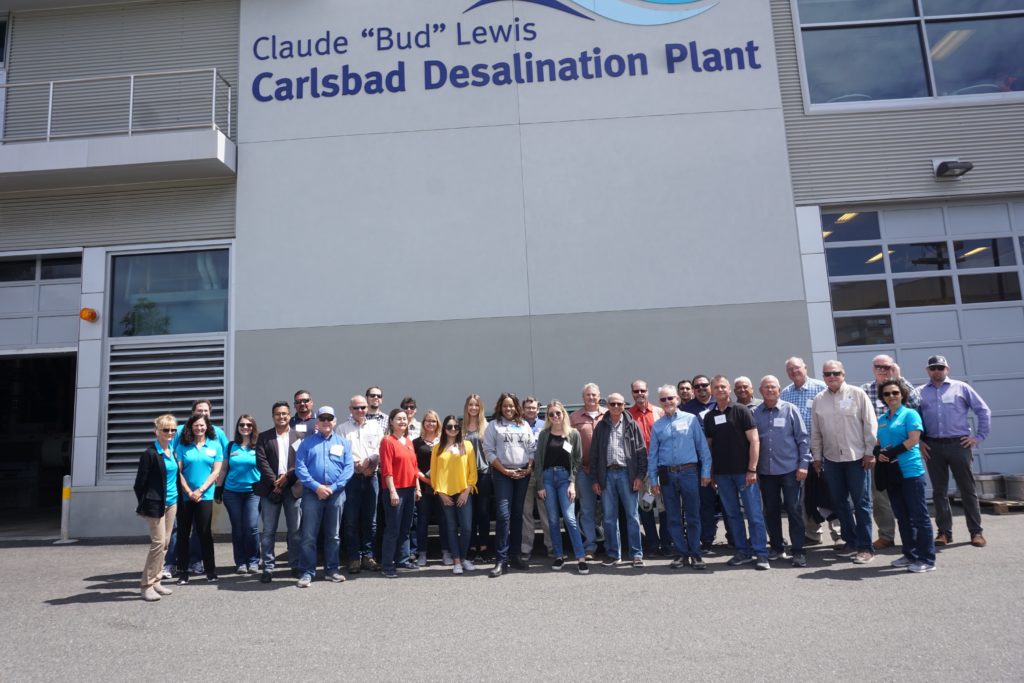
Recently, there was some discussion on social media locally that suggested the San Diego County Water Authority should invest in seawater desalination and consider other supply development in the San Diego region. This blog is in response to that important dialogue and hopefully will provide some helpful information to further the discussion, build awareness of the Water Authority and provide some context for the Quantification Settlement Agreement (the QSA).
The first key point is that the Water Authority has in fact invested in desalination. In 2015, the Claude “Bud” Lewis Carlsbad Desalination Plant became operational as the largest such desalination plant in the Western Hemisphere. The plant provides 50 million gallons of water per day and represents about ten percent of the San Diego region’s supply—or one-third of the water generated in San Diego. The plant supplies water to about 400,000 people each year. The desalination plant was built as part of an innovative public-private partnership involving a water purchase agreement between the Water Authority and Poseidon Water. The desalination project, like the QSA, stands as an example of a complex, controversial decision that ultimately benefits generations to come.
Up until the Coronavirus struck California, the Water Authority would host annual tours for Imperial Valley residents to visit the plant along with other facilities in San Diego focused on water management and supply development. It’s also important to note that the Water Authority Board of Directors would also visit the Imperial Valley to learn about steps taken in the Valley under the Quantification Settlement Agreement (QSA) to conserve water and discuss projects and issues pertaining to the Salton Sea. When it is safe to do so again, the Water Authority looks forward to resuming such tours and interaction. That communication is key to building awareness and understanding of the issues both the Imperial Valley and San Diego face when it comes to managing water supplies while also being good stewards of the environment.
Bringing the desalination plant online was no easy task. It had been in development since 1998. However, it was a necessary step, representing part of a supply diversification strategy launched by the Water Authority when a prolonged drought in the 1980s had a severe impact on San Diego’s supplies. It became clear at that time that the San Diego region could not rely on one source of water (provided by the Metropolitan Water District of Southern California) as it had in the past.
A critical aspect of that water diversification strategy is the conserved water transfer agreement between the Imperial Irrigation District and the Water Authority in which IID and farmers in the Valley conserve up to 200,000 acre-feet of water per year in a program funded by the Water Authority. That conserved transfer water, together with another approximately 80,000 acre-feet of water conserved through the lining of sections of the All-American and Coachella Canals (funded by the Water Authority and through state proposition funds), is vital to the San Diego region. That conservation is also critical to the QSA, the means by which California has better managed its Colorado River supply. The Water Authority appreciates the partnership with IID and the willingness of the farming community to participate in the conservation program. However, while the QSA supplies make up about half of the Water Authority’s supply portfolio, it would be incorrect to think that the Water Authority solely relies on QSA supplies (collectively the conserved transfer water and the canal lining water).
Along with the Water Authority’s strategy of diversifying supplies, over the past decades, we have also focused efforts on implementing a series of capital improvement projects known collectively as the Emergency and Carryover Storage Project, a system of reservoirs, interconnected pipelines and pumping facilities. Largely complete, they help ensure water is available to the region in the event imported supplies were ever interrupted and to facilitate effective water supply management. The system of reservoirs also allows for the capture and storage of local runoff. Additionally, the Water Authority supports our member agencies in their local supply development projects, including water reuse projects to turn recycled water into safe drinking water, further development of desalination opportunities, and groundwater recovery.
The point here is that it should be known there are a number of steps being taken in the San Diego region to both manage and generate local supplies. The QSA, however, remains an essential part of our diversification strategy while complimenting local supply development efforts. The Water Authority appreciates the strong working relationship with IID and is committed to continuing to be a good partner to the Imperial Valley. That includes remaining a steadfast member of the QSA Joint Powers Authority, working with IID, the Coachella Valley Water District and the state to implement mitigation projects at the sea that can work hand in hand with the state’s restoration efforts. The sea is a critical part of the Colorado River system and efforts will continue to address it. Further, the sea has to be considered in any future discussions related to the operations of the Colorado River. As always, feel free to contact QSA Outreach Coordinator Darren Simon at dsimon@sdcwa.org or at 760-337-1386 with any questions.
